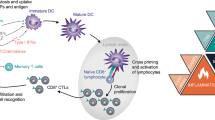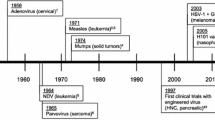Abstract
Alterations in the immunogenic properties of tumor cells frequently accompany selection for multipledrug-resistant (MDR) variants. Therefore, studies were performed to examine the hypothesis that overexpression of membrane P-glycoprotein, commonly observed in MDR tumor cells, is associated with enhanced immunogenic properties. Immunogenicity was determined by (a) the ability of drug-sensitive parental UV2237M fibrosarcoma cells and drug-resistant UV2237M variant cells to immunize normal mice against rechallenge with parental tumor cells and (b) the ability of normal syngeneic mice to reject cell inocula that caused progressive tumor growth in immunocompromised mice. Variant UV2237M cell lines included subpopulations selected for a six- to ten-fold increase in mRNA for P-glycoprotein and expression of the MDR phenotype (resistance to doxorubicin) and cells sensitive to doxorubicin (and no expression of MDR properties) but resistant to ouabain. All UV2237M drug-resistant cells were highly immunogenic in immunocompetent mice, regardless of their MDR phenotype. Additional studies showed that CT-26 murine adenocarcinoma cells, sensitive or resistant to doxorubicin (expressing high levels of P-glycoprotein), injected into normal syngeneic Balb/c mice produced rapidly growing tumors. The data do not demonstrate a correlation between the immunogenic properties of drug-resistant tumor cells and the expression of P-glycoprotein.
Similar content being viewed by others
References
Bech-Hansen NT, Till JE, Ling V (1976) Pleiotropic phenotype of colchicine-resistant CHO cells: cross-resistance and collateral sensitivity. J Cell Physiol 88: 23
Bucana CD, Giavazzi R, Nayar R, O'Brian CA, Seid C, Earnest LE, Fan D (1990) Retention of vital dyes correlates inversely with the multidrug-resistant phenotype of Adriamycin-selected murine fibrosarcoma variants. Expt Cell Res 190: 69
Cifone MA, Fidler IJ (1981) Increasing metastatic potential is associated with increasing genetic instability of clones isolated from murine neoplasms. Proc Natl Acad Sci USA 78: 6949
Curt GA, Clendeninn NJ, Chabner BA (1984) Drug resistance in cancer. Cancer Treat Rep 68: 87
Dano K (1973) Active outward transport of daunomycin resistant Ehrlich ascites tumor cells. Biochim Biophys Acta 323: 426
Deffie AM, Alam T, Senevirantne C, Beenken SW, Batra JK, Shea TC, Henner WS, Goldenberg GJ (1988) Multifactorial resistance to Adriamycin: relationship of DNA repair, glutathione transferase activity, drug-efflux, and P-glycoprotein in cloned cell lines of adriamycin-sensitive and resistant P388 leukemia. Cancer Res 48: 3595
Deffie AM, Butra JK, Goldenberg GJ (1989) Direct correlation between DNA topoisomerase II activity and cytotoxicity in Adriamycin-sensitive and -resistant P388 leukemia cell lines. Cancer Res 43: 58
DeVita VT Jr. (1983) The relationship between tumor mass and resistance to chemotherapy. Cancer 51: 1209
Dexter DL, Leith JT (1986) Tumor heterogeneity and drug resistance. J Clin Oncol 4: 244
Fan D, Bucana CD, O'Brian CA, Zwelling LA, Seid C, Fidler IJ (1990) Enhancement of murine tumor cell sensitivity to Adriamycin by presentation of the drug in phosphatidylcholine-phosphatidylserine liposomes. Cancer Res 50: 3619
Feinberg AP, Vogelstein B (1983) A technique for radiolabeling DNA restriction endonuclease fragments to high specific activity. Anal Biochem 132: 6
Fidler IJ, Cifone MA (1979) Properties of metastatic and nonmetastatic cloned subpopulations of an ultraviolet-light-induced murine fibrosarcoma of recent origin. Am J Pathol 97: 633
Fidler IJ, Poste G (1985) The cellular heterogeneity of malignant neoplasms: implications for adjuvant chemotherapy. Semin Oncol 12: 207
Flintoff WF, Nagainis CR (1983) Transport of methotrexate in Chinese hamster ovary cells: a mutant defective in methotrexate uptake and cell binding. Arch Biochem Biophys 223: 443
Fort P, Marty L, Peichaczyk M, Sabrouty SE, Dani C, Jeanteur P, Blanchard JM (1989) Various rat adult tissues express only one major mRNA species from the glyceraldehyde-3-phosphate-dehydrogenase multigenic family. Nucleic Acids Res 13: 1431
Fortner GW, Lill PH (1985) Immune response to ultraviolet-induced tumors. I. Transplantation immunity developing in syngeneic mice in response to progressor ultraviolet-induced tumors. Transplantation 39: 44
Frei E III (1982) The national cancer chemotherapy program. Science 217: 600
Gambacorti-Passerini C, Rivoltini L, Supino R, Rodolfo M, Radrizzani M, Fossati G, Parmiani G (1988) Susceptibility of chemoresistant murine and human tumor cells to lysis by interleukin 2-activated lymphocytes. Cancer Res 48: 2372
Gerlach JH, Endicott JA, Juranka PF, Henderson G, Sarangi F, Deuchars KI, Ling V (1986) Homology between P-glycoprotein and bacterial hemolysin transport protein suggests a model for multidrug resistance. Nature 324: 485
Giavazzi R, Miller L, Hart IR (1983) Metastatic behavior of an Adriamycin-resistant murine tumor. Cancer Res 43: 5081
Goldie JH, Coldman AJ (1984) The genetic origin of drug resistance in neoplasms: implications for systemic therapy. Cancer Res 44: 3643
Gros P, Ben Neriah Y, Croop JA, Housman DE (1986) Isolation and expression of a complementary DNA that confers multidrug resistance. Nature (Lond) 323: 728
Heppner GH, Dexter DL, De Nucci T, Miller FR, Calibresi P (1985) Heterogeneity in drug sensitivity among tumor cell subpopulations of a single mammary tumor. Cancer Res 38: 3758
Killion JJ (1978) Immunotherapy with tumor cell subpopulations. II. Therapy of drug-resistant L1210 leukemia and EL4 lymphoma. Cancer Immunol Immunother 5: 21
Kimmig A, Gekeler V, Neumann M, Frese G, Handgretinger R, Kardos G, Diddens H, Niethammer D (1990) Susceptibility of multidrug-resistant human leukemia cell lines to human interleukin 2-activated killer cells. Cancer Res 50: 6793
Kripke ML (1977) Latency, histology and antigenicity of tumors induced by ultraviolet light in three inbred mouse strains. Cancer Res 37: 1395
Kripke ML (1991) Immunological effects of ultraviolet radiation. J Dermatol 18: 429
Kripke ML, Gruys E, Fidler IJ (1978) Metastatic heterogeneity of cells from an ultraviolet-light induced murine fibrosarcoma of recent origin. Cancer Res 38: 2962
LeFever AV, Killion JJ, Kollmorgen GM (1976) Active immunotherapy of L1210 leukemia with neuraminidase-treated, drugresistant L1210 sublines. Cancer Immunol Immunother 1: 211
Ling V, Thompson LH (1974) Reduced permeability in CHO cells as a mechanism of resistance to colchicine. J Cell Physiol 83: 103
Marquardt D, Center SM (1992) Drug transport mechanisms in HL60 cells isolated for resistance to Adriamycin: evidence for nuclear drug accumulation and redistribution in resistant cells. Cancer Res 52: 3157
Mihich E, Kitano M (1971) Differences in the immunogenicity of leukemia L1210 sublines in DBA/2 mice. Cancer Res 31: 1999
Nicolin A, Vadlamudi S, Goldin A (1972) Antigenicity of L1210 leukemia sublines induced by drugs. Cancer Res 32: 653
Radinsky R, Culp LA (1991) Clonal dominance of select subsets of viral keirstenras +-transformed 3T3 cells during tumor progression. Int J Cancer 48: 148
Radinsky R, Kraemer PM, Raines MA, Kung H-J, Culp LA (1987) Amplification and rearrangement of the kirstenras oncogene in virus-transformed BALB/c 3T3 cells during malignant tumor progression. Proc Natl Acad Sci USA 84: 5143
Riodan JR, Ling V (1985) Genetic and biochemical characterization of multidrug resistance. Pharmacol Ther 28: 51
Scheper RJ, Dalton WS, Grogan TM, Schlosser A, Bellamy WT, Taylor CW, Scuder P, Spier C (1991) Altered expression of P-glycoprotein and cellular adhesion molecules on human multidrug-resistant tumor cells does not affect their susceptibility to NK- and LAK-mediated cytotoxicity. Int J Cancer 48: 562
Sharp JD, Capecchi NE, Capecchi MR (1973) Altered enzymes in drug-resistant variants of mammalian tissue culture cells. Proc Natl Acad Sci USA 70: 3145
Staroselsky AN, Fan D, O'Brian CA, Bucana CD, Gupta KP, Fidler IJ (1990) Site-dependent differences in response of the UV-2237 murine fibrosarcoma to systemic therapy with Adriamycin. Cancer Res 50: 7775
Staroselsky AN, Radinsky R, Fidler IJ, Pathak S, Chernajovsky Y, Frost P (in press) The use of molecular genetic markers to demonstrate the effect of organ environment on clonal dominance in a human renal-cell carcinoma grown in nude mice. Int J Cancer
Streeter PR, Fortner GW (1988) Immune response to ultraviolet-induced tumors. II. Effector cells in tumor immunity. Transplantation 46: 250
Tsuruo T, Iida H, Kawabara H, Tsukagoshi S, Sakurai Y (1984) High calcium content of pleiotropic drug-resistant P388 and K562 leukemia and Chinese hamster ovary cells. Cancer Res 44: 5095
Author information
Authors and Affiliations
Additional information
Supported in part by core grant CA-16672 R35-CA42 107 from the National Cancer Institute, and postdoctoral fellowship grant PF-3446 from the American Cancer Society (R. R.)
Rights and permissions
About this article
Cite this article
Killion, J.J., Radinsky, R., Dong, Z. et al. The immunogenic properties of drug-resistant murine tumor cells do not correlate with expression of the MDR phenotype. Cancer Immunol Immunother 36, 381–386 (1993). https://doi.org/10.1007/BF01742254
Received:
Accepted:
Issue Date:
DOI: https://doi.org/10.1007/BF01742254




